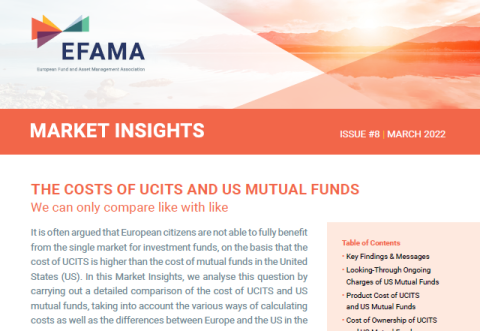ESMA’s Call for Evidence on the UCITS Eligible Assets Directive is a welcome opportunity to take stock of the existing UCITS framework.
UCITS
UCITS (Undertakings for Collective Investment in Transferable Securities) refers to the EU framework for harmonising the creation, management and marketing of collective investment schemes in the EU (and EEA) Member States. It places a strong focus on investors’ protection and product regulation. Owing to this harmonised framework, once UCITS funds are registered in one Member State, they can be freely marketed across the European Union. Initially adopted in 1985, the UCITS Directive has since been modified repeatedly, to take into account developments in financial markets.
EFAMA is adamant to protect the competitiveness and international appeal of UCITS.
High-level response to ESMA consultation on notifications for cross-border marketing and management of AIFs and UCITS
EFAMA welcomes the European Securities and Market Authority’s continuous commitment to creating a single market for investment funds, confirmed by the draft regulatory standards currently under consideration. These RTS/ITS would further harmonise information that asset managers should provide to their national competent authorities before marketing or managing an investment fund on a cross-border basis, thus facilitating intra-EU product distribution.
EFAMA reply to ESMA CP on marketing communications guidelines
EFAMA believes that ESMA’s draft ‘marketing communication’ Guidelines still require important clarifications to ensure full alignment between them and MiFID II’s Commission Delegated Regulation Article 44. This alignment is essential to ensure coherent rules for fund management companies and distributors. Unfortunately, parts of the proposed Guidelines are overly prescriptive and may unintentionally make some marketing materials vaguer or even inconsistent with local MiFID requirements for distributors.
Net Returns and Fund Costs: A Nuanced Look at Value in UCITS
This article was first published in the 23rd edition of the Fact Book on 24 June 2025.
Given the emphasis on costs and value for money for European investors, we have examined whether lower fees consistently translate into better net performance. Our analysis shows that this is not always the case; less-expensive funds do not necessarily deliver the highest returns, and in some instances, higher-cost funds outperform.
UCITS Net Returns in 2024 and So Far in 2025
This article was first published in the 23rd edition of the Fact Book on 24 June 2025.
The rise of active ETFs in Europe – A short overview
EFAMA is pleased to launch the first edition of its new Industry Perspective research series, entitled “The rise of active ETFs in Europe – A short overview”.
This publication gives a brief summary of the active ETF market in Europe, including its characteristics, growth over time, and comparison to the active ETF market in the US.
Key trends in active ETFs:
The costs of UCITS and US mutual funds | Market Insights | Issue #8
It is often argued that European citizens are not able to fully benefit from the single market for investment funds, on the basis that the cost of UCITS is higher than the cost of mutual funds in the United States (US). In this Market Insights, we analyse this question by carrying out a detailed comparison of the cost of UCITS and US mutual funds, taking into account the various ways of calculating costs as well as the differences between Europe and the US in the way investment funds are distributed.
Fund managers retain only 41% of the total cost paid by retail investors | Market Insights | Issue #6
EFAMA has released its latest Market Insights report titled “Perspective on the costs of UCITS”. The full report breaks down the costs of UCITS, focusing on the fees charged for the different services provided along the investment fund value chain and distinguishing between the product cost for which fund managers are directly responsible, and the
Market Insights | Issue #5 | Perspective on the net performance of UCITS
Equity UCITS delivered a total net return of 108% in real terms in 2010-2019, whereas bank deposits lost 10% in net value





































